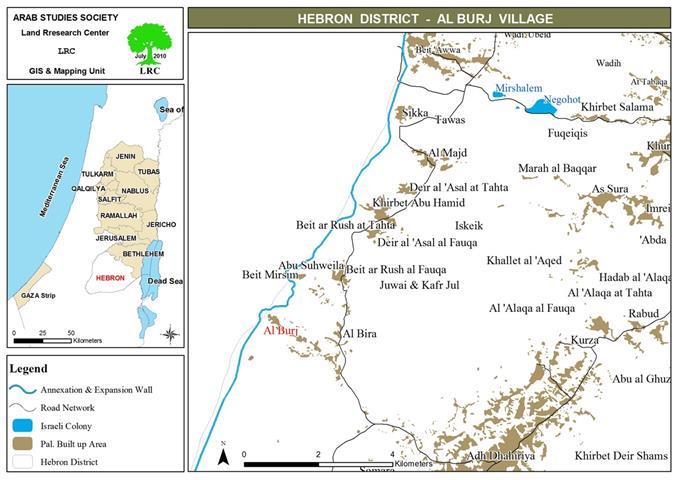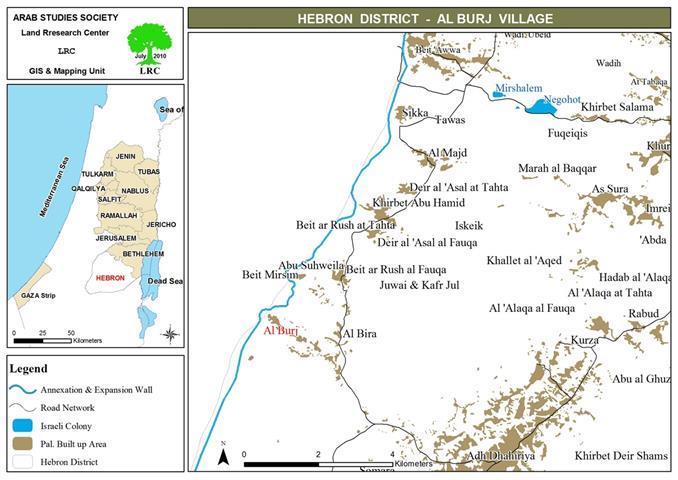The Israeli Occupation Forces handed villagers of Al Burj 12 military orders, entitled stop work and construction orders, against various ‘illegal’ structures; the Israelis say that the designated structures were built without receiving the needed permits. A hearing session will be held in Beit El Military Court on July 29, 2010 in order to resolve the issue, probably by returning the designated locations to its status quo.
It was mentioned in the military orders that the owners can apply for permits but their applications shall not guarantee receiving a permit. It must be pointed that tens of stop-work and demolition orders have been issued against structures in Hebron city and its surroundings, one of these orders rendered a whole village [Sha’b al Butum – Yatta] illegal and facing a demolition threat.
Table 1: Threatened Structures:
|
No.
|
Landlord
|
Family
members
|
Children
|
Construction
year
|
Structure
type
|
Status
|
Area
(m2)
|
stories
|
# Picture
|
|
1
|
Zyad Talahma
|
7
|
5
|
2007
|
residential
|
Under construction
|
200
|
2
|
|
|
2
|
Husein Talahma
|
5
|
3
|
2007
|
residential
|
Inhabited
|
200
|
2
|
|
|
3
|
Musab Talahma
|
6
|
3
|
2008
|
residential
|
used
|
150
|
1
|
|
|
4
|
Nidal Talahma
|
4
|
2
|
2009
|
residential
|
Under construction
|
240
|
2
|
|
|
5
|
Fahmi al Masharqa
|
8
|
6
|
2007
|
Barn
|
used
|
1000
|
1
|
|
|
6
|
Isma’el al ‘Awawda
|
12
|
4
|
2009
|
Barn
|
used
|
550
|
2
|
|
|
7
|
Khalil Talahma
|
6
|
4
|
2009
|
residential
|
Under construction
|
200
|
1
|
|
|
8
|
‘Adnan Talahma
|
10
|
5
|
2009
|
Barn
|
Under construction
|
160
|
1
|
|
|
9
|
Jamal al Masharqa
|
7
|
5
|
2008
|
residential
|
Under construction
|
220
|
2
|
|
|
10
|
Maher Sh’ar
|
1
|
0
|
2006
|
Shed
|
Under construction
|
300
|
1
|
|
|
11
|
Khalil al Masharqa
|
9
|
2
|
2007
|
shed
|
used
|
130
|
1
|
|
|
12
|
Munzir al Masharqa
|
1
|
0
|
2008
|
residential
|
Under construction
|
200
|
1
|
|
|
Total
|
76
|
39
|
|
|
|
3550
|
17
|
|
The owners expressed fear of the fate of their houses and families if they lost their shelter and urged all the humanitarian bodies to put pressure onto Israel to prevent it from carrying out the orders. The locals tried to explain the difficulties they faced through the construction phases since most of them suffer from financial crisis. They bought the land and built their houses trying to escape the crowded heart of the village. Others built barns and chicken huts in an attempt to increase their income which was drastically affected by the construction of the segregation wall and the inability to have jobs inside the ‘Green Line’.
Al Burj:
Picture 13: Al Burj – an overview
It is located 25 km to the south west of Dura town. Its total area is 6 km2. it is surrounded by a number of Palestinian towns and villages besides the wall that borders the western side of the village. The village is inhabited by around 3000 people who largely depend on agriculture in their living. The village affairs are administered by a village council. Withing its boundaries, there exist two schools, one for males and the other for females, 3 mosques, a kindergarten, a sports club, and a maternity clinic.
Picture 14: the Israeli colonist who took over the ‘Bayyarat al Burj’ spring
Like all the other localities around Dura, the village suffers from extreme water shortage. Before the year 2000, the village used to depend on a water network for its water supply. However, the Israelis cut the water supply in 2000. The villagers were forced to find an alternative which was the nearby water springs. However, the water shortage became severe when an Israeli colonist took over the main water spring which the locals used to largely depend on.
The Israeli Segregation Wall:
Picture 15+16: a section of the Israeli segregation wall around the village –
colonial roads surrounding the village can be viewed as well
The Israeli segregation wall devoured large areas of Al Burj western and southern parts in 2005. One third of the village lands were lost to the wall. The Israeli Occupation Authorities banned the Palestinians from reaching their lands many times by putting earth mounds that block the agricultural roads. In addition, the Israeli constructed a breaker which extracts rocks and break it into smithereens used for construction purposes. The Israeli facility drastically damages the environment and causes constant disturbance because of the demolitions used for rocks extraction.































